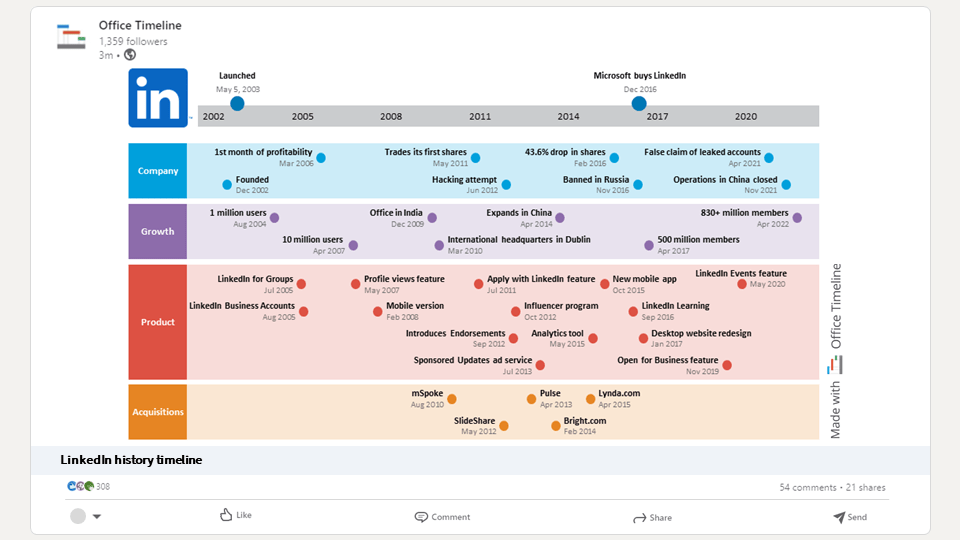Updated on July 29, 2022
On May 5, 2003, what was to become one of the largest and best-known companies in Silicon Valley in less than two decades was launched under the name of LinkedIn. Built as a business-oriented social network, it has now grown into a massively successful public company that generates billions of dollars in revenue and boasts more than 800 million members. As if anticipating the pivotal role that the online platform would play in bringing professionals worldwide together, founder Reid Hoffman dubbed the launching date as Cinco de LinkedIn.
To honor the business networking site that changed the way we find jobs, collaborators, or potential employees, we wanted to take a look back at how it all started and created this blog post, which includes a visual timeline that marks some of the major events in its evolution. Pinpointing landmarks such as the time LinkedIn was founded, its first month of profitability, its acquisition by Microsoft and 500M member milestone, the graphic also includes important product features released throughout the years, such as Groups (seen as one of the best ways to network on LinkedIn even to this day), or the popular “Who’s viewed your profile” feature.

History of LinkedIn: a timeline
- December 2002: LinkedIn is founded
- May 5, 2003: LinkedIn’s official launch
- August 2004: 1 million users reached
- July 2005: LinkedIn’s “Groups” feature is added
- August 2005: Business accounts are instated
- April 2007: 10 million users reached
- May 2007: “Profile views” feature is released
- February 2008: LinkedIn’s mobile version is introduced
- September 2008: Targeted advertising campaigns
- December 2009: LinkedIn opens office in Mumbai, India
- March 2010: International Headquarters set up in Dublin
- August 2010: LinkedIn’s first acquisition, mSpoke
- May 2011: Trading its first shares
- July 2011: “Apply with LinkedIn” feature released
- May 2012: LinkedIn acquires SlideShare
- June 2012: First hacking attempt against the network
- September 2012: LinkedIn introduces endorsements
- October 2012: Kickstart of influencer program
- April 2013: LinkedIn acquires Pulse
- July 2003: Sponsored Updates ad service
- February 2014: Bright.com acquisition
- April 2014: LinkedIn expands in China
- April 2015: Lynda.com acquisition
- May 2015: Analytics tool integrated
- October 2015: New mobile app is introduced
- February 2016: 43.6% drop in shares in a single day
- September 2016: LinkedIn’s Learning Solutions division is set up
- November 2016: LinkedIn is banned in Russia
- December 2016: LinkedIn’s acquisition by Microsoft
- January 2017: Desktop website redesign
- April 2017: 500 million users reached
- November 2019: “Open for Business” feature launched for freelancers and SMEs
- May 2020: “LinkedIn Events” launched to help organizations connect safely in real time
- April 2021: False claim that 500 million LinkedIn accounts were leaked online
- October 2021: Microsoft ends LinkedIn operations in China
- February 2022: LinkedIn’s membership exceeds 830 million
Frequently asked questions about LinkedIn
If you want to go beyond our summarized LinkedIn history timeline and find out more, check out below the answers to the most frequently asked questions about the popular employment-oriented company.
Yes, LinkedIn also offers a Basic (free) account apart from its premium, paid subscriptions.
Here is what a free LinkedIn account allows you to do:
· Find and reconnect with colleagues and classmates.
· Request and provide recommendations.
· Search for and view other LinkedIn members’ profiles.
· Save a maximum of three searches and get weekly alerts on those searches.
· Receive unlimited InMail messages.
Based on LinkedIn’s quarterly SEC filings, its main source of revenue is generated by its talent solutions (recruitment services), marketing solutions (advertising sales), and premium subscriptions (membership privileges). A supplementary revenue driver is the company’s learning division, Learning Solutions.
LinkedIn was founded in December 2002 by Reid Hoffman, Eric Ly, and other team members from Socialnet.com and PayPal (namely, Stephen Beitzel, Allen Blue, David Eves, Konstantin Guericke, Lee Hower, Ian McNish, Yan Pujante, Chris Saccheri, Jean-Luc Vaillant).
With LinkedIn’s acquisition completed in December 2016, Microsoft is the current owner/parent company of the business networking site which runs its operations and services under the leadership of Ryan Roslansky.
LinkedIn filed for an initial public offering in January 2011 and traded its first shares on May 19, 2011.
The LinkedIn idea started out in the co-founder Reid Hoffman’s living room in December 2002 and materialized through the official launch of its associated website on May 5, 2003.
After its launch in May 2003, LinkedIn slowly gathered a mere 245 members by the end of that same year. However, once Sequoia Capital led the Series A investment in the company, LinkedIn took off and reached 1 million users in 2004, seeing accelerated growth as more features were rolled out to appeal to small business owners. With membership exceeding 1 million and two business lines launched (Jobs and Subscriptions) by 2005, LinkedIn started generating revenue and reached profitability in March 2006.
As things got more lucrative throughout 2007, Reid Hoffman decided to focus on running the product and stepped down from the role of CEO, passing the reigns to Dan Nye. In 2008, after 5 years dedicated to growing within the U.S., LinkedIn took the first steps toward becoming a global social network, opening international offices in the UK, Spain, and France. One year later, it started its Asia-Pacific team expansion, with offices set up in Mumbai, India and Sydney, Australia.
Hitting a huge growth milestone with 90 million members and 1,000 users in 2010, LinkedIn opened an International Headquarters in Dublin, Ireland, and received a $20 million investment from Tiger Global Management LLC at a valuation of approximately $2 billion. In January 2011, LinkedIn went public and started trading four months later.
Once its IPO was filed, LinkedIn invested in improving its website’s underlying infrastructure to allow faster revision-release cycles and saw its earnings soar due to the company’s increased success in the social media world. This gained attention from Microsoft, which decided to acquire LinkedIn for 196$ a share in December 2016, the deal’s total value amounting to $26.2 billion and making for the second largest acquisition made by Microsoft to date.
Since then, LinkedIn had seen steady growth until 2020, when the COVID pandemic forced the leadership to lay off about 6% of its total workforce, from the talent acquisition and global sales teams. The following year, Microsoft decided to end LinkedIn operations in China.
As of February 2022, LinkedIn has more than 830 million registered members from over 200 countries and territories.
Based on the total number of registered members from a specific country, statistics show that the U.S. uses LinkedIn the most (with over 171 million users), followed by India, where the count rises to more than 69 million members.
About the LinkedIn history timeline
The LinkedIn history timeline was created in PowerPoint using the Office Timeline add-in and can be downloaded for free as a PowerPoint slide. To make quick edits to the graphic, we recommend using the free 14-day trial of Office Timeline. This tool can be of great help to users requiring advanced customization options and is ideal for building professional visuals and business presentations.

Turn project data into professional timelines
Get the advanced features of Office Timeline Pro+ free for 14 days.
Get free trial